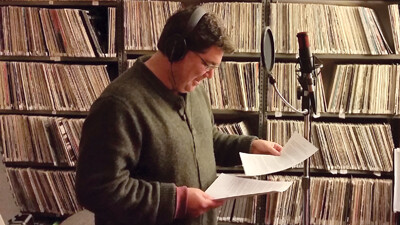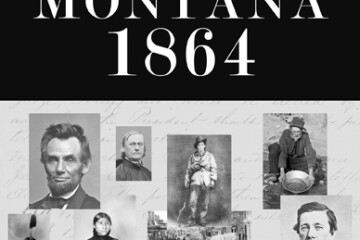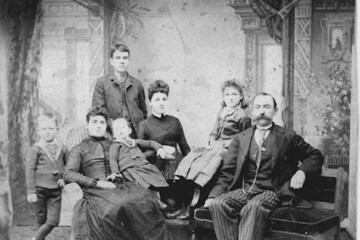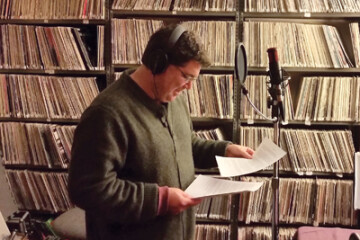Interview with B. Derek Strahn
The Montana Medicine Show’s Genuine Montana History
As I steer my two small sons (ages 3 and 5) into the recording studios at KGLT, I can see a curly-haired, 40-something guy putting on his headphones and getting ready to record. He’s framed by record-lined (yes, the vinyl LP kind) walls in a cluttered recording booth where he’s preparing to record four new, two-minute segments for his radio program, The Montana Medicine Show.
This spectacled man, named Derek Strahn, with his warm smile and a twinkle in his eye, seems to be the type of character you might find in one of his own Montana history tales. He’s the kind of person you just want to sit down with in front of a warm fire, serve up hot cocoa, and kindly demand, “Tell me everything you know about Montana’s past!”
In addition to being a radio host, writer, and historic preservationist, Derek also teaches Advanced Placement U.S. History and Native American Studies at Bozeman High School where he’s worked since 2002. While I didn’t bring any hot chocolate to our interview, I did have the opportunity to spend some time talking with him about his new book. Here’s what he had to say:
JC: What are the radio show and the book about?
DS: The book, The Montana Medicine Show’s Genuine Montana History, is comprised of historical vignettes that are part of a collection of radio broadcasts from The Montana Medicine Show—a weekly program produced at the studios of KGLT (91.9 FM on the campus of Montana State University in Bozeman) since 2008. The purpose of the radio show and the book is to entertain; to raise an eyebrow and to get people more informed about a place that I care about deeply, and I hope they’ll care about too.
The descriptions in the book are rich and meaningful. We really tried to select a diverse range of topics to include: women and minorities, and all sorts of geographic regions of the state. The stories, even though they’re short, are packed with colorful descriptions and quirky facts that make the book engaging and, hopefully, interesting.
JC: How did the radio show, The Montana Medicine Show, come to be?
DS: It was the brainchild of Jim Kehoe, KGLT’s program director. Several years ago he approached me with the idea of writing and recording brief radio pieces that feature snapshots from Montana history. The idea was intriguing, but honesty I was skeptical. I knew that simply telling an accurate two-minute story was challenging; researching and writing a concise weekly radio broadcast that someone might actually want to listen to seemed almost impossible. (Besides, my voice sounded funny on radio.) But here we are six years later, having published a book and making future plans for the radio show.
JC: How did you pick the name of the show?
DS: Engineer Brodie Cates came up with the name, and it just seemed to fit. Medicine shows were roving nineteenth and early twentieth century caravans that traveled from town to town. They featured fast-talking showmen that peddled snake oil for a wide range of ailments, while also providing a wide range of entertainments—songs, dance acts, comedy routines, freak shows, and storytelling—to draw the crowds in. These part-vaudeville show, part-drugstore, part-circus-on-wheels were especially popular in the West.
JC: Why did you decide to write the book, and how did the project evolve?
DS: My publisher, Chris Cauble, from Riverbend Publishing had heard the radio show and really liked it. He decided that it would make a good book. Last spring he approached me about putting something together for publication. We dusted off some of the old scripts, did some editing and came up with the book.
JC: Why is this book relevant to today’s Montanan?
DS: Even though we have this rich history and people have very deep roots here, the story of Montana is oftentimes a transient story; it’s people passing through or making a quick buck and taking off, or coming in with big dreams and failing and having to move on. It’s important for people to recognize that there’s a story behind these vistas; that this is a place that has seen some glory days and it’s seen really hard times. If you have a sense of that, you appreciate the place a lot more. My hope would be that our community would be more willing to stand up and preserve aspects of Montana because they know more about it.
JC: Why a historical book?
DS: I think almost everybody, whether you’re a kid or an adult, loves history. It’s a shame that so many of us had the old history teacher with the overhead projector taking notes on the screen. That type of history teaching has killed history for a lot of people, and they don’t come back to it until much later in life. Most people do come back to it eventually though; they read history for enjoyment, visit historic places on vacation, and watch historic movies. There is this need in all of us to somehow be connected to the past. And if someone can do that through a book or radio show, then I think it’s worth it.
One of Derek’s favorite character’s (among many) from the book is a Blackfoot Indian woman named Running Eagle, who defied traditional women’s roles to become one of the only (if not the only) known female war chief. In the 1840s, fur trader John Rowand likely encountered Running Eagle in Cree country. He described: “a war party of 1,000 men who had…at their head the Queen of the Plains.”
-An excerpt from The Montana Medicine Show’s Genuine Montana History
Meet the author, and hear some of Derek’s stories for yourself at the Country Bookshelf on December 9th at 7pm. He will be reading from the book and discussing some of its themes followed by a book signing of The Montana Medicine Show’s Genuine Montana History.



